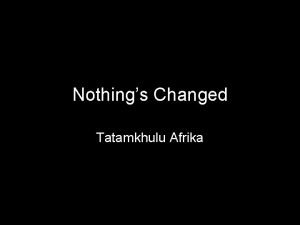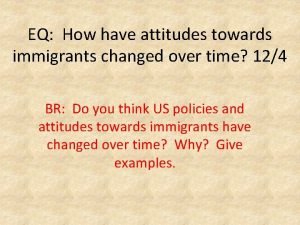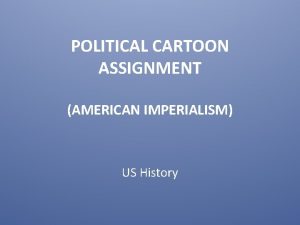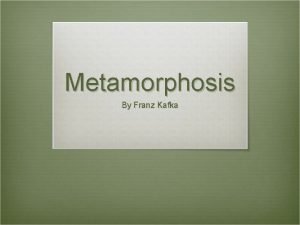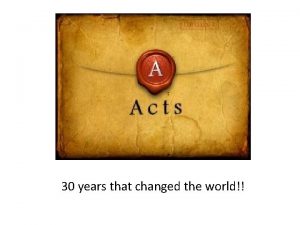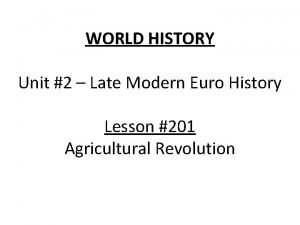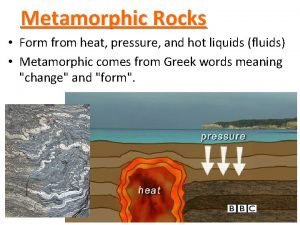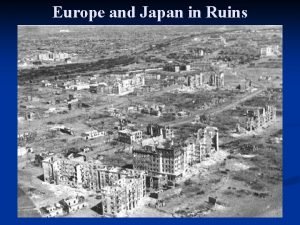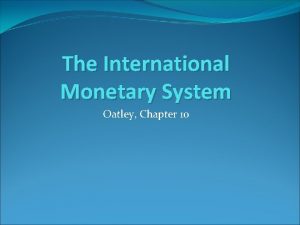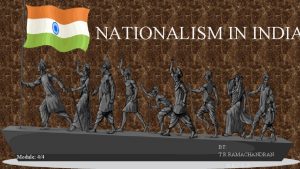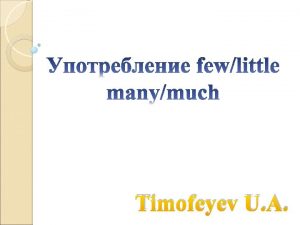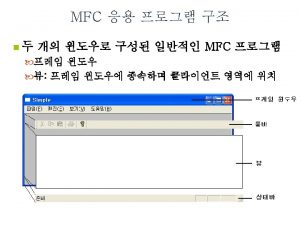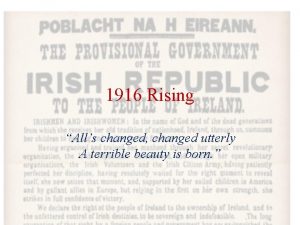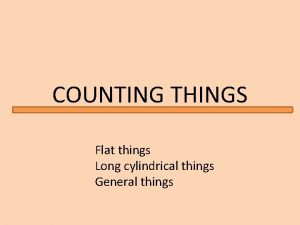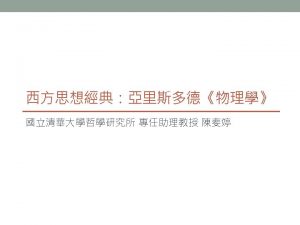How a Few Simple Things Changed History Class



















































- Slides: 51

How a Few Simple Things Changed History Class 4 William A. Reader E-mail: wreader@cox. net 1

What We Will Cover Today • The Impact of Tobacco (continued) – Industrialization & Cigarette Smoking – Tobacco, the Roaring 20 s & the World Wars – Cigarettes & Cancer • The Impact of the Potato – Some Notes About the Potato – Consequences of the Potato – The Irish Potato Famine – French Fries, Fast Food & Mc. Donald’s 2

The Industrialization of Smoking • Cigarette smoking did not take off until the creation of brand-name advertising and the invention of the Bonsack cigarette-manufacturing machine • Prior to the Bonsack machine, cigarettes were made by hand – This made them very expensive since a skilled cigarette roller could make no more than 5 cigarettes per minute • Motivated by a $75, 000 prize, James Bonsack patented a cigarette-manufacturing machine that could roll 212 cigarettes a minute 3

Growth of Cigarette Smoking • The Bonsack Machine greatly reduced the cost of manufacturing cigarettes and hence the cost of smoking them • In the Industrial world, cigarettes were the most convenient means of smoking – Pipes took time to fill and longer to smoke – Chewing tobacco was seen as a health hazard – Cigarettes were portable and sociable 4

Tobacco & World War I - 1 • Smoking proved very popular in the trenches of World War I due to – Its relaxing properties – Its ability to suppress hunger – It constituted the one bit of civilian normality in the trenches – Its sociability aspects • The militaries of all nations involved approved of smoking and issued cigarette rations – U. S. tobacco rations consisted predominantly of cigarettes 5

Tobacco & World War I - 2 • The combination of need-fulfilling popularity and official rations turned many a doughboy into a cigarette smoker • On the home front, many woman war plant workers became smokers • Both of the above facts paved the way for the cigarette smoking boom of the 1920 s 6

The “It” Girls • After World War I, the “It” Girls, daughters of the well-to-do, began both to frequent public places after dark without chaperones and to smoke in public – The media, especially the movies, popularized the “It Girl” and her lifestyle, which included the smoking of cigarettes and fashionably slender figures 7

Cigarettes & Advertising • In the 1920 s, advertising began to develop new approaches – Focusing on the consumers’ alleged or feared failings and anxieties and then demonstrating how the advertiser’s product could eliminate the failings and relieve the anxieties • The tobacco companies exploited women’s fear of being fat with their “Reach for a Lucky instead of a sweet” 8

Cigarette Branding • While branding dates back to the 18 th century (Cadbury & Wedgwood), large scale use of branding began just before the end of the 19 th century. By the 1930 s, brand names were firmly established • Tobacco companies were big into branding their cigarettes. – The three leading brands of the 1920 s – Camel, Chesterfield, and Lucky Strike – had distinct brands and images 9

Movies & Smoking • Movies popularized smoking by showing movie stars smoking and by portraying everyday people as smoking • Tobacco companies in turn paid actors tp publicize the fact that they smoked their brand of cigarettes • Cigarettes served as a prop to illustrate a person’s character or suggest an erotic act (that in itself could not be shown) 10

Movies & Smoking - 2 • Thanks to the impact of World War I, clever advertising, and movies a majority of adults now smoked – In 1930, Count Curti, a tobacco historian, observed that ‘non-smokers are a feeble and ever dwindling minority’ and that governments of all stripes encouraged smoking for the taxes it brings 11

The Nazis & Smoking • Hitler was a non-smoker who conducted a tax and propaganda war against smoking – Raised taxes on cigarettes – Banned smoking by pregnant women and Luftwaffe pilots – Forbade smoking in public places and on public transport – Fostered research into the effects of smoking • First studies linking cigarette smoking and lung cancer 12

The Nazis & Smoking • Hitler’s efforts, however, were generally unsuccessful – Between 1932 and 1939, smoking per capita rose from 570 cigarettes per annum to 900 • During World War II, smoking decreased as a result of an inability to import tobacco – The cigarette ration for German soldiers was 6 person per day – less than what it had been in World War I 13

World War II & Cigarettes • Roosevelt declared tobacco an essential wartime material and granted draft exemptions to those who grew it – US troops had a tobacco allowance of 5 to 7 packs a week – From 1944 on, cigarettes were included in combat rations • World War II turned GIs into smokers 14

World War II & Cigarettes - 2 • GIs who smoked were intensely brand loyal • Transit camps for GIs heading home from Europe were named after brands of cigarettes – Camp Chesterfield • Cigarettes served as an unofficial currency in the POW camps of World War II • Cigarettes also served as an unofficial currency in Allied-occupied Germany 15

Cigarettes & Cancer • The May 1950 issue of the JAMA published two studies strongly linking smoking to lung cancer – Lung cancer rates were 10 times greater than for non-smokers – 96. 4% of hospitalized lung cancer patients were heavy-to-chain smokers • In 1957, US Surgeon General Leroy Burney issued a Joint Report of Study Group on Smoking and Health, which stated that, 'prolonged cigarette smoking was a causative factor in the etiology of lung cancer'. • In 1964, the surgeon general report, 1964 surgeon general's report, Smoking and Health: Report of the Advisory Committee to the Surgeon General of the Public Health Service, strongly stated that there was a link between cigarette smoking and cancer (especially lung cancer) 16

Tobacco Company Reaction - 1 • In 1954, the U. S. tobacco companies placed an advertisement in 448 newspapers. – Entitled “Frank Statement to Cigarette Smokers, ” the ad stated that the medical studies “are not regarded as conclusive in the field of cancer research” and that there is no proof that cigarette smoking is a cause of lung cancer • In the 1950 s, the tobacco companies introduced filter and menthol cigarettes 17

Tobacco Company Reaction- 2 • After the 1964 Surgeon General’s report, the tobacco companies reacted by – Attacking the credibility of the research, stating that it was purely statistical in nature and that correlation was not causation – Hiking their advertising budgets and promoting cigarettes in ever novel ways • One outcome was the “Marlboro Man” & another later one was Joe Camel – Using political clout to forestall significant regulation 18

Cigarette Culture Wars • One consequence of studies linking smoking to lung and other cancers and the tobacco companies’ reactions was – The cigarette culture wars – pitting groups who wanted to restrict smoking by means of government regulation vs groups who argued for ‘smokers’ rights’ 19

Passive Smoking • The one factor that tipped the balance of the culture war over tobacco have been studies that suggested that cigarette smoke in the environment could cause lung cancer in nonsmokers – This had led to bans on smoking in public (including public modes of transportation) and other restrictions 20

The Impact of the Potato 21

Potato 22

Potato Plant Flowers 23

What is a Potato? • Potato = a : an erect South American herb (Solanum tuberosum) of the nightshade family widely cultivated for its edible starchy tuber b: the tuber of a potato plant 24

Some Notes About the Potato - 1 • Potato plants are herbaceous perennials that grow about 24 in high, depending on variety. They bear white, pink, red, blue, or purple flowers with yellow stamens. Potatoes are cross-pollinated mostly by insects which carry pollen from other potato plants, but a substantial amount of self-fertilizing occurs as well. 25

Some Notes About the Potato - 2 • There are nearly 4, 000 different varieties of • In general, varieties are categorized into a few main groups, such as russets, reds, whites, yellows (also called Yukons) and purples— based on common characteristics. Around 80 varieties are commercially available • For culinary purposes, varieties are often classified as Baking potatoes (20– 22% starch) or Boiling potatoes (16– 18% starch). 26

Some Notes About the Potato - 3 • Potatoes were originally domesticated in the region of Lake Titicaca, and then spread throughout the Andes and beyond • Potatoes were a mainstay of the Inca along with corn and beans • Europeans first learned of potatoes in the 1530 s when the Spanish conquered the Inca Empire 27

Some Notes About the Potato - 4 • Europeans were initially suspicious of the potato • By the 17 th century, potatoes were widely regarded as suitable fodder for animals but not for humans except as a last resort – The potato made slow progress, being consumed only by the very rich (aristocratic gardeners) and the very poor (first in Ireland, and then in parts of England, France, the Low Countries, the Rhineland, and Prussia) 28

Some Notes About the Potato - 5 • In the 18 th century, a series of famines and wars helped popularize the potato – When crops failed, European governments promoted the potato as an antidote to starvation – War promoted the potato in two ways: • European soldiers who fought in potato-growing areas noted that the potato was delicious to eat and constituted a food source that was safe from army foragers since it remained hidden underground 29

Some Notes About the Potato - 6 • One person who helped popularize the potato was Antoine-Augustin Parmentier. He – Eulogized the potato in a prize-winning essay – Persuaded the medical faculty of the Sorbonne to endorse the potato – Organized a series of publicity stunts to make potatoes fashionable 30

Some Notes About the Potato - 7 Millions of Calories per Acre Crop Yield Potatoes 7. 5 Million Corn 7. 3 Million Wheat 4. 2 Million Oats 5. 5 Million Barley 5. 1 Million 31

Some Notes About the Potato - 8 • During and after the Napoleonic Wars, the potato became the staple food of the poor. – In Germany, 1 million tons of potatoes were grown in 1814; in 1914, about 50 million tons were grown • Potatoes are a source of protein, amino acids, dietary fiber, vitamin C, vitamin B 6, folate, niacin, iron, potassium, and calories 32

Consequences of the Potato - 1 • Starting in the last half of the 18 th century, population grew in Europe, China, India, Sub. Saharan Africa, and the Americas. • There were two reasons for this – One was the warming climate due to the end of the Little Ice Age – A more important one was the spread of American food crops – especially potatoes, corn, manioc, and sweet potatoes – to the Old World 33

Consequences of the Potato - 2 • In Europe, population grew from 103 million in 1650 to 274 million in 1850 – In Ireland, the population increased from around 500, 000 in 1660 to 9, 000 in 1840 – something that would have been impossible without the potato • By the mid-19 th Century, potatoes not only became the chief food of the lower classes but proved to be tasty to the pig population – This led to increased consumption of pork, ham, and bacon 34

Consequences of the Potato - 3 • Population growth in Europe had the following effects: – Cultivation of formerly uncultivated land – Migration of rural young people to the cities or overseas – Expansion of handicraft manufacturing in the countryside – Stimulation of the Industrial Revolution by supplying a large number of employable young people – Rural unrest in France which culminated in the French Revolution 35

Consequences of the Potato - 4 • By creating a large rural population dependent on the potato, the conditions for the 1840 s potato famine in Ireland western Europe were laid 36

Consequences of the Potato - 5 • The one exception to population growth was the Middle East – Increased drought as a result of global warming – Middle Eastern climate was generally not suitable for most Western Hemisphere-origin food crops • The exceptions were areas subject to irrigation where corn was sometimes grown 37

Irish Potato Famine - 1 • By 1835, the earlier Irish potato varieties had given way to the Lumper – a highly productive potato that had originated as animal fodder in England were easily raised on poor soil – The Lumpers were normal staple of Irish animals and the poor over much of the south and west of Ireland • Lumpers did not keep from one year to the next so that they could not be stockpiled as a cushion against a poor harvest. 38

Irish Potato Famine - 2 • As a result of the potato, Ireland’s population rose rapidly • In the 1840 s, land was subdivided into minimum size parcels that would support a family for which extortionate rents were charged – 1½ acres of potatoes would feed a family of 5 or 6 for a year as long as there was a cow to provide milk 39

Irish Potato Famine - 3 • In 1842 and 1845, a potato blight fungus - Phytophthora infestans - infected potatoes along the Atlantic coast of North America • In 1845, that fungus came to Ireland Western Europe from North America – The potato famine not only affected Ireland but also Western Europe – The crop failed again in 1846. Potato crop failure was aggravated by poor cereal crop harvests that year – Successive crop failures meant that in 1847, a lack of seed potatoes meant that only a fifth of the normal acreage was planted. In 1848, the blight reappeared and caused the total failure of the crop. 40

Effects of the Potato Famine - 1 • Over one million Irish and 100, 000 Western Europeans died as a result of the famine and the diseases that spread in its wake • Over one million Irish emigrated, with more than 500, 000 settling in the United States. About one million emigrated from the Scottish Highlands • It precipitated discontent in Western Europe, helping to precipitate the revolutions of 1848 and the subsequent migration of a large number of Germans and Scandinavians to the U. S. 41

Effects of the Potato Famine - 2 • Led to population decline in Ireland for the rest of the century as a result of emigration, delayed marriage, and celibacy – Emigration rates remained high, averaging 90, 000 people annually in the 1860 s • Led to the repeal of the British Corn Laws – The Corn Laws had been a bone of contention between landowning aristocrats who favored them and industrialists (and workers) who wanted their abolition 42

Repeal of the Corn Laws • Represented the triumph of free trade over protectionism • Led to an eventual decline of British agriculture as cheaper wheat from the U. S. and Continental Europe flowed into Britain – By 1900, 80% of Britain’s wheat was imported 43

Effects of the Potato Famine - 3 • Created psychological scars – fears of starvation and eviction – and hatred of the English that were to run deep in Irish society – scars and hatreds that were to strongly influence the politics of Ireland Irish diasporas in America 44

Effects of the Potato Famine - 4 • Effects of Irish Famine emigration to the U. S. – Led to the growth of political machines in northern U. S. cities – Destabilized American politics in the decade before the Civil War • Fostered a nativist anti-Catholic reaction among native Protestants that led to the creation of the Know-Nothing Party, the weakening of the Democrats, and the destruction of the Whigs – This paved the way for the rise of the Republican Party and the Civil War • Increased the relative population of the North, intensifying Southern fears of political marginalization – this in turn intensified pro-secession sentiment 45

Effects of the Potato Famine - 5 • Effects of Irish Migration to the U. S. – 2 – Changed the character and role of the Catholic Church in America • Prior to the Irish Famine migration, the American Catholic Church had been the church of a small minority of largely well-to-do persons of English and French extraction • After the migration, the Church became a church of lower-class and working-class Irish • Gave the Church an ethos of sexual puritanism that reflected the sexual repression induced by the famine 46

French Fries - 1 • French fried potatoes (Pommes frites) were based on an 18 th century Parisian recipe that Thomas Jefferson brought back to the U. S. in 1802, but they didn’t catch on in the U. S. until the 1920 s – In the 19 th century, Americans ate their potatoes baked, boiled, or mashed. – U. S. servicemen who had enjoyed fried potatoes in France popularized them in the U. S. in the 1920 s 47

French Fries - 2 • Drive-in restaurants in the 1930 s & 1940 s served french fries which popularized them even more – French fries could be served without a fork or a knife and could be eaten while driving, but were very time-consuming to prepare • In the early-1950 s, J. R. Simplot and Ray Dunlap devised a precooked frozen french fry that could be mass produced using the Russet Burbank potato 48

French Fries - 3 • In 1965, Simplot met with Ray Kroc – Prior to meeting Simplot, Mc. Donald’s had been obtaining fresh potatoes from 175 different suppliers with restaurant crew members spending a lot of time and labor peeling and slicing potatoes – Kroc agreed to build a factory solely for the manufacture of Mc. Donald’s french fries and became the main supplier of french fries to Mc. Donald’s • The reduced cost of using frozen french fries made this item one of the most profitable items on Mc. Donald’s menu 49

Impact of the Frozen French Fry • Fostered the growth of the fast-food restaurant • Led Idaho to replace Maine as the nation’s chief grower of potatoes • Turned the potato market into an oligopsony – a market of a small number of buyers and a large number of sellers – Result is diminished income for the farmers • Gave a vast boost to the flavor industry 50

Impact of Mc. Donald’s • The expansion of Mc. Donald’s overseas has: – Led foreigners to see Mc. Donald’s as representing Americana and the promise of modernization – Driven many traditional native restaurants out of business in their own homelands • For example, the traditional German restaurant – serving schnitzel, knockwurst, sauerbraten & beer - is rapidly disappearing in Germany which Mc. Donald’s has over a thousand restaurants there – Has made Mc. Donald’s, instead of the American embassy, the most likely target of anti-American demonstrations 51
 She is lucky she has few problems
She is lucky she has few problems Few ja a few ero
Few ja a few ero Fill in a few a little
Fill in a few a little Complete the sentences.use the following words
Complete the sentences.use the following words Unit 10 things that changed the world
Unit 10 things that changed the world My favourite thing poem
My favourite thing poem Simple machines have got few or no moving parts
Simple machines have got few or no moving parts Ecosystem living and nonliving things
Ecosystem living and nonliving things Seven life processes
Seven life processes Simple past simple present will future
Simple past simple present will future Simple present and simple future
Simple present and simple future Present simple present continuous past simple future simple
Present simple present continuous past simple future simple Present simple present continuous past simple
Present simple present continuous past simple Simple present simple past and simple future
Simple present simple past and simple future Present simple continuous past simple continuous exercises
Present simple continuous past simple continuous exercises Have en futuro simple
Have en futuro simple Present simple
Present simple Present simple present continuous 4 класс
Present simple present continuous 4 класс Nothing's changed by tatamkhulu afrika
Nothing's changed by tatamkhulu afrika How have attitudes towards immigrants changed over time
How have attitudes towards immigrants changed over time Jacob name changed to israel
Jacob name changed to israel What is process capability baseline
What is process capability baseline What does the picture depict
What does the picture depict How computers have changed over time
How computers have changed over time Setting of metamorphosis
Setting of metamorphosis Aral sea changed over time
Aral sea changed over time Truss abc is changed by decreasing
Truss abc is changed by decreasing Organisms changed because they wanted to survive
Organisms changed because they wanted to survive Asian american inventions
Asian american inventions 30 years that changed the world
30 years that changed the world Enclosure movement
Enclosure movement I will always write back quotes
I will always write back quotes Rocks changed by temperature pressure and hot liquids
Rocks changed by temperature pressure and hot liquids Where does angus say they will meet the oncoming army
Where does angus say they will meet the oncoming army Living a changed life
Living a changed life How has technology changed sports
How has technology changed sports Dave grolsh
Dave grolsh Hypothesis statement example
Hypothesis statement example Lord i come to you let my heart be changed
Lord i come to you let my heart be changed Five equations that changed the world
Five equations that changed the world Three ways war affected the land and people of europe.
Three ways war affected the land and people of europe. Ways electrification changed american life
Ways electrification changed american life Has the exchange rate changed chapter 10
Has the exchange rate changed chapter 10 When the word oat is changed to the word boat the number of
When the word oat is changed to the word boat the number of Indian flag changed how many times
Indian flag changed how many times Has the exchange rate changed chapter 10
Has the exchange rate changed chapter 10 Energy can be changed from one form to another
Energy can be changed from one form to another Also history physical
Also history physical Are we having class today
Are we having class today Putting a package together
Putting a package together Abstract class vs concrete class
Abstract class vs concrete class Lower class boundary of the modal class
Lower class boundary of the modal class


















